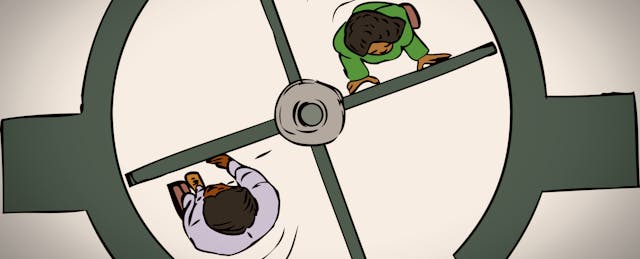The Days of Daycare Are Over: Rebuilding includes renaming

Photo by Aaron Burden on Unsplash
We’ve learned a lot of things in these past years; one of the biggest lessons was that no less than our national economic recovery depends on child care.
For decades, the lives of American families has increasingly been built around using some form of child care.
Across America, most adults work.
Less than 1/3 of children have a full-time, stay-at-home parent.
This is a big change from only one generation ago when more than ½ of children had a full-time stay-at-home parent.
The face of the workforce has changed a lot too.
71% of women with children under 18 are working.
This is up nearly 25% since the 70s.
The pace of innovation has changed so many things in our lives, but the childcare system has largely been left behind. Maybe because you can’t — or shouldn’t — automate caregiving or replace an educator with a computer. Maybe because the respect for early education has never been high in America. Maybe because we focus more on perceived loss, than proven gains. Maybe because it’s been stuck in a political argument for decades. No matter: we’ve built lives, careers, and routines around this system, despite it being inefficient, expensive, complicated, and inconsistent in access and quality. Organizations, providers, and even the U.S. military have figured out how to work within the system and offer high-quality programs for millions of young children. The business community has gotten involved, offering child care as a benefit. Economists have proven a high ROI of high quality care and learning. But the first years of this decade have picked this brittle patchwork system up and threw it back down, exposing the deep fissures for all of us to see. Not only could we see how fragile the system was, the country had a reckoning with how dependent we were upon it.
Two years later, the recognition of how valuable child care is to all of us as a country is stronger than it’s ever been. Finally, those that dedicate their careers to the first years of childhood — the time in life with the most brain development — are lauded as essential. The discussion has quickly moved beyond whether parents should use child care, to how important early care and learning is. The film on the glass has been scrubbed clean and it’s crystal clear that child care is not just a family issue or working mother need, but instead, a vital part of our society. And while this has been a welcome shift — despite the reason — and there is federal and state prioritization on getting the child care industry back on its feet, we don’t want to return to how it was before. Business as usual was broken. We never would have asked for the global pandemic, but now that we’re here we want this moment to be a catalyst to fix the system, to do what we know is best for young children, to support the lives of working families, and to empower the careers of working women (those offering early care & learning programs; and those that use the programs). And this starts with the words we use.
The early care and education field is steeped in science — or, at least it should be. Research like this, this, this, and this is abundant; the findings are clear; we know what works. Yet, there is a wide swath of quality and a fragmented market system that allows trends, opinions, bloggers, income levels, and state/city/county regulatory systems and politicians to shape what is offered. The first years of life are exciting and consequential for the next 100. We cannot — we must not — leave this to chance.
Sure, the term daycare fits some of what is offered, but it doesn’t fit what should be offered: what all families should want and what all children deserve. The history of caring for young children is fraught with false narratives and antiquated mindsets we’ve worked hard to overcome: the idea that caring for children is women’s work, that using care outside of the home reflects badly on the mother, that child care is damaging, that parents should feel guilty if they put their child in care, that child care is dirty, the list goes on. All of this thinking is hitched to the term daycare. It’s time to move on.
Our field deserves a name worthy of its impact. Only then can we make the progress that we need to and shift the discourse from if to how. When we recognize and name our field for what it is, we can start addressing the widespread challenges that exist. And there’s a long list.
We need to stop debating whether it’s safe for children to be in early care and learning settings.
We need to differentiate unregulated custodial care from sophisticated science-informed early learning.
We need to unapologetically define and insist on high-quality.
We need to treat early educators and care providers with respect and gravitas building educational and career pathways.
We need to eliminate the unfounded argument that care and learning are separate and that care is less important than learning. Care is foundational to learning.
We need to halt the harmful pushdown of ineffective teaching methods and academic expectations while elevating the robust and rigorous developmental experiences that do, in fact, help a child flourish.
We need to insist on shared standards built on volumes of empirical research.
We need to put the joy and play back into childhood knowing this is essential for children’s healthy early development and a strong foundation for life.
And we need to fix the inequities, quality disparities, and access challenges so all children experience early care and learning that unlocks their full potential despite family income or zip code.
As a country, we’re lagging…badly. No matter what metrics we use, we’re shamefully behind other countries when it comes to early care and learning. And this has never been our M.O. Early care and learning is not a safety net or social program; a quality child care system is a public good. It impacts national health, GDP, and the success of the next generation. So whether we call ourselves early education, early care and learning, or some other combination of these words, let’s ditch the term daycare and get on with rebuilding a system that rises to the occasion, that meets the moment, and accelerates our livelihoods and economy forward.
There’s no time to waste, the children are waiting.
-Rachel Robertson
https://medium.com/@rlsrobertson/the-days-of-daycare-are-over-rebuilding-includes-renaming-abec79df4d21



